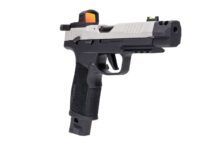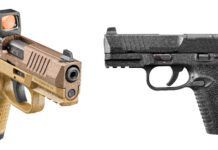Smallbore bullseye competition shooting requires a steady hand, top-notch trigger control, focus-and an accurate gun that functions consistently. We pitted two updated newcomers that are safely out of the plinking class based on their price and model names-Rugers Mark III Competition (KMKIII678GC, $555) and Brownings Buck Mark Bullseye Target Stainless (No. 051426490, $643)-against Smith & Wessons venerable Model 41 (No. 130512, $1,115) to settle two questions. First, could the two more economical brands offer something to shooters looking to become serious in the sport?; and second, does the S&W still have the performance its historically been known for? The answers to both parts were yes, but we were so disappointed in several aspects of all three pistols that we cant justify more than a conditional buy on any of them.
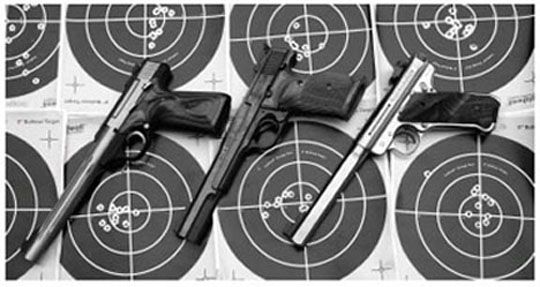
We shot all three from the MTM bench and Caldwells On Target pistol rest (both from Midway USA), first at 15 yards and then at 25 yards, both slow fire and rapid fire. We used four different brands of ammunition, mostly because .22s are notorious for favoring one brand over another when it comes to accuracy, and sometimes functionality. They included Federals Champion AutoMatch, a 40-grain lead solid point; Remingtons brass-plated hollowpoints; CCIs Mini-Mag Standard Velocity; and Remingtons Eley Match EPS, with its heavily lubed, flat-nosed 40-grain lead bullet. With one single exception, each fired flawlessly at all times, and some fairly decent groups were had by all three, though our testers are not competitive bullseye shooters. Trigger pull was measured with an RCBS trigger-pull scale, also supplied by Midway USA. Heres what we found.
Browning Buck Mark
Bullseye Target Stainless
.22 LR No. 051426490, $643
We shot the Browning first, attracted to its handsome good looks. Brownings .22 pistols dont always look “serious.” In fact, in our experience, the overall weight of most of the pistols in the Buck Mark lineup relegate them to the casual fun/plinking category. This one is an exception. Wearing a long 7.25-inch barrel, the Buck Mark Bullseye weighs in at 2.44 pounds. This weight sits decidedly in front of the hand, but it almost proved too much so; when we tested ourselves by simply holding on target with an empty gun, focusing on how much the front sight moved around, we had a hard time controlling the circular wobble. We dont doubt that consistent practice to improve muscle memory, such as any serious competitive bullseye shooter would do, would improve this, but as we didnt notice this with the other two pistols, it must be noted. The wobble wasnt a huge issue, but noticeable, and we feel that had Browning put a couple more ounces in the back of the light alloy frame and slide, that the wobble would have been eliminated-or at least reduced and more controllable. Too, they could have deepened the six flutes (three on each side of the barrel) to remove some ounces there; as it is, the grooves look more aesthetic than a practical application of either weight reduction or increasing barrel surface for cooling purposes.
Its too bad the balance was too far forward on this pistol, because it fits in the hand wonderfully. At its fattest point, the grip measures 5.8 inches in circumference. It possesses ambidextrous thumb ridges on either side, though the right side on the 4.25-inch-tall grip also flares at the bottom for a right-handers pinkie rest; our main test shooter didnt get her pinkie anywhere near this flare, so this guns factory grips, which are of a very attractive, well-grained rosewood, will accommodate a huge variety of hand sizes. We also found the overall size of the grip allowed for a lot of different hand positions to best accommodate proper trigger access, and we never felt the trigger-finger side “thumb” ridge got in the way; we actually felt to the contrary, that it actually seemed to aid better alignment to the trigger. The only drawback to the grip was the rosewoods smooth finish. Though pretty, and only simply adorned with the Buck Mark symbol on either side, checkering would have provided a better grip. We didnt have the gun slide around on us, but its not a hard leap to imagine how slick and hard to track consistently this gun might become on a hot summer day.
We liked the Buck Mark Bullseyes controls, for the most part. The slide release and safety levers sit on top of the left grip panel and stick out well enough for easy access. Both push down in a positive, firm manner. We even found the safety, because it stuck out so well, provided an excellent alternative thumb rest, and we experienced no slide burn at all when using it thusly. The only control we wish was more accessible was the magazine release. It sits right in front of the left grip panel thumb rests point and is recessed in relation to it. This forces a total realignment of the shooting hand to access. We wish it was more prominent-larger and protruding more-for quicker access with less hand shifting. It did function flawlessly, truly shooting out the 10-round magazine upon depression. This pistol does sport a magazine disconnect.
We really enjoyed shooting this single-action only pistol. The front sight tracks cleanly up to the right and settles right back where it started, important in a bullseye pistol. Of the three, recoil was in the middle. About what youd expect from a .22 target pistol with a long heavy barrel. The trigger, which is adjustable for over travel, has just enough slack to allow the shooter to rest the finger on it without setting it off, and a comfortably small amount of controlled squeeze cleanly broke the trigger at 2.75 pounds. This was the lightest trigger pull of the three.
We found the sights on the Buck Mark to our liking. The fully adjustable Pro-Target rear sight frames the 0.125-inch-wide blade with enough room on either side to allow a good and consistent reference to the target. Using the black Orange Peel targets from Midway USA, we never had to guess at whether we were returning to the same sight picture from shot to shot. And that led to some pretty consistent groups from our non-bullseye-competitive test shooters. Best of all, the gun was pretty dead-on out of the box-we never touched the sights throughout the entire range of testing and ammo switching.
We actually liked the Buck Mark Bullseye so much we thought we had a total winner-until we disassembled it. The steps are easy enough, but the manual is confusing. The directions for the Buck Mark, Buck Mark Plus, and Bullseye models instruct the following: “With an empty pistol, first remove the rear sight base screws and washers and remove the sight assembly. Next, pull back on the slide a bit and remove the guide rod, spring, and firing pin housing, then lift the slide off the frame.” The instructions then tell the user to stop there, that no further disassembly is necessary. Yet there is a picture directly underneath this that shows the barrel disassembled from the frame. Browning tells you how to get the barrel off, but only in the instructions for 5.5 Field and 5.5 Target models. Huh? You should only take the barrel off on some of the Buck Mark pistols? And as this pistol has both the words “bullseye” and “target” in its full model name, does it fit in one category but not the other?
Well, we took off the barrel on our sample anyway, following the instructions to unscrew the barrel mounting screw in front of the trigger guard. The accompanying picture in the manual shows a flat-tipped screwdriver being used, along with captions that say it should take, specifically, 3.5 counterclockwise turns. Problem was, we had no flat-tip screw. What we had was a deeply recessed Allen screw, one that took many more than 3.5 turns to loosen sufficiently enough so that the barrel could be tipped forward and removed.
That front barrel mounting screw wasnt the only part missing. Also absent was one of the two toothed lockwashers under the rear sight base screws. That seems pretty minor-until you read the warning in big red letters in the Buck Mark manual that warns not to lose these as disassembling the rear sight from the frame may be “very difficult” without them. The discovery of the missing parts pretty much deflated our high on this pistol.
Ruger Mark III Competition
.22 LR No. KMKIII678GC, $555
The biggest changes we could ascertain between the new Ruger Mark III Competition and its many predecessors are the safety upgrades. We counted four safeties altogether. Theres the standard on/off thumb-activated safety at the left rear of the frame, the magazine disconnect, a loaded firearm indicator on the slide (new), and an actual key lock that locks the safety into place (new). Of the four, the only one that disappointed was the one that Rugers touting the most, its loaded-gun indicator. The device is narrow, though clearly marked in upper-case letters with the words “LOADED CHAMBER INDICATOR,” and is flush to the rounded slide housing when the gun is unloaded. If loaded, the toggled bar sticks out, revealing a bit of warning orange and the word “LOADED” on top of the stuck-out edge. But theres so little orange-whats there looks accidental-and sticks out so little, its easy to miss. We feel the entire edge-top and end-of the portion that sticks out when the gun is loaded, should stick out more and be totally painted in warning orange.
Safeties are all well and good, but are there any other reasons to choose this Ruger, especially at more than half a grand retail, when there are always a plethora of used Rugers to be had with considerably less cash outflow?
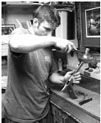
Wed have to say no. This gun functioned fine, as flawlessly as the others, though we didnt initially think it was as accurate; groups were less than desirable for the first 200 rounds, but on our third hundred, suddenly sucked together. It seemed the gun needed a little breaking in, not unusual for any gun, and particularly for .22s. But we didnt like the way the gun felt in the hand while firing, or its recoil and tracking pattern.
Our first criticism is that the grip is too narrow front to back (the 6-inch max circumference reading in the spec box was taken around the grips fattest point, which includes the thumb rest-as the hand never really grips this part, take that spec with a grain of salt). Paired with grips that have a one-sided thumb rest that force the hand into one position only, our main test shooter couldnt get her trigger finger correctly on the trigger without pulling that finger significantly away from the off-side grip. And it doesnt take a Camp Perry winner to know that if
youre hooking your finger through the trigger, things are not going to go well. Big hands are going to have lots and lots of trouble getting comfortable with this gun.
The Ruger, we felt, is better balanced than the Browning. At 45 ounces unloaded, the weight fell to the front, but not so tip-forward as the Brownings, thanks to the all-steel frame. With its 6.88-inch barrel, it had more weight distributed directly in the front of the hand than the Browning, and as a result it was nearly rock steady when held in the traditional, one-handed bullseye stance. But it didnt shoot comfortably. In addition to vibration on recoil-we could feel the recoil through the whole gun, rather than just the muzzle jump we felt on our other two in the lineup-it tracked up and to the left
. It also didnt settle back in the hand or the rest well at all. We just couldnt fire and have the sights end back where we started, and serious shooters should find this disturbing in the rapid-fire sequences of competitive tournaments. Complicating the matter more, we didnt feel the rear sight provided enough space in the framing of the front sight, further reducing our ability to reference a consistent aiming point on the target.
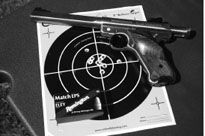
Controls on the Ruger left something to be desired. The bolt close, for instance, is wedged between the top of the grip and the top of the frame, which flares outward to meet the rounded receiver/bolt housing. It will be hard to access for large hands/thumbs. The safety can be easily flipped off with the hand in the shooting position, but could not be flicked back on without moving the hand far out of position, thanks to its very rearward position on the frame and the huge hump in the grip thumb rest. The grip design proved to be problematic with the magazine release, as well, which is right next to but far below the rise in the wood. We did note that the magazine release worked flawlessly, though it didnt always shoot the magazine completely out of the gun as the Browning did. The magazine did have a thumb follower button that was prominent enough to be helpful in loading the magazine, but it must be noted that the magazine on the new Mark III Competition is not interchangeable with other .22 pistols of older generations, nor vice-versa.
The final below-par grade went to the trigger. We felt there was an inordinate amount of travel/slack before we could get to the tension. At 3.75 pounds, it was spongy and actually felt heavier than that; we were surprised at the consistent scale reading. There was also substantial overtravel after the break.
Controls are one thing, and subject to personal preference as far as positioning goes. It was the disassembly and the users manual that nearly earned the Mark III a complete “F.” Ruger .22 semi-auto pistols have always been notoriously difficult to take apart and put back together. One of our test shooters, who worked behind the counter of a retail gun shop for a number of years, can recall more than a few customers coming in-some repeatedly-with Mark Is and IIs that simply could not be put back together by the average gun hobbyist. The new Mark III proved to be no exception. We even took it to one tester who has had years of practice taking these pistols apart and putting them back together, and he just about put this gun in the circular recycle bin. He even at one point exclaimed, while trying to get the bolt to drop out, “What do I have to do next, hop on my left foot while pulling the trigger three times and saying Mother may I? before this thing will let go?!”
The answer, it turned out, was very nearly a yes. Disassembly/reassembly of the Mark III is some evil combination of the Hokey-Pokey and Simon Says, with the devil running both shows simultaneously. An example from the 4.5 pages of instructions for these tasks: At some point approximately half-way through the disassembly production, the user is supposed to reinsert an empty magazine, point the muzzle toward the ceiling, and pull the trigger, all to get the bolt to drop out the back end. We dont care how familiar one is with handguns, no one would ever guess that such actions would be part of the disassembly process. You cannot take this gun apart by feeling your way through it. The manual is mandatory. You will also, on more than one occasion, wish you had three hands, and you will need a vise grip, a soft mallet, a drift pin, and a flat-tip screwdriver, none of which are included with the gun.
Not scared yet? Try putting the III back together, because this process is not the reverse of what it took to get it apart. There are half a dozen warnings about aligning this part or that part just so, and some of these are beyond important, because its just not a matter of getting the gun back together-its a matter of not completely ruining the gun when you do. Case in point: Step number 5 in the reassembly lineup tells the user to “BE CERTAIN” the firing pin stop, a very small part that the user has never been instructed to remove in the first place, is still in the bolt. We assume this implies that it can fall out on its own, but the worst part of this is that should this pin disappear and the user not notice it, the first time he or she next fires the gun, “… the firing pin will fly forward so far as to irreparably dent the rear end of the chamber of the barrel, making the pistol useless.” All because the user was missing an engineering degree.
We also didnt appreciate that some of the nomenclature isnt explained in the manual. For instance, where the manual explains the new Mark III magazines and why theyre different from other Mark-series mags, it explains that the Mark III mags have a new “trigger lock window and protrusion” and then directly references a page further on that will explain what this is. But the referenced page contains no such highlighted illustration with a caption, no explanation of what it is or what it does. In fact, theres no reference to it at all. If were not supposed to use other Ruger .22 magazines with this gun, and this “trigger lock window and protrusion” is the feature that differentiates the mags one from another, shouldnt there be some visible illustration of just what this feature is?
Smith & Wesson M
.22 LR No. 30512, $1115odel 41
From a shooting standpoint, it was easy to see why the Model 41 continues to hold the interest of the competitive bullseye shooting crowd. The gun is lovely. Fit and finish are flawless, classy, and if old-fashioned compared to the flashier Browning and Ruger, its a design that works.
Like the Browning, the 41 provides a relatively wide grip, in this case 6 inches in circumference at its widest point. Better than the Browning, though, it swells at the backstrap, allowing for a better variety of hand positions to best fit the palm well of each individuals hand. The ambidextrous thumb rest, while not as prominent as the Brownings, was also nowhere near as radical in rise or slope as the Rugers, which echoed the user benefits of the 41s backstrap shape. We also liked the wide checkering inserts, which offered excellent purchase.
We favored most of the controls on the S&W. The slide release is cantilevered over the grip, is easy to access, and provides an alternate thumbrest. We experienced no slide burn when using it that way, and it dropped the slide assuredly. The magazine release is located at the front of the left grip thumbrest and is recessed, but the least so of the three in our lineup. We found it the easiest to access, and with little shifting of the shooting hand compared to the other two. It did drop the magazine out cleanly and reliably, and the Model 41 has a magazine disconnect safety like our other two test guns.
We also liked the sights. While the fully adjustable rear provided about the same framing of the front
blade as the Ruger (rather narrow), because the S&W possesses a lower-profile sight, finding and repeating the same aiming reference point was far less of a problem than with the Ruger.
The trigger on the S&W was by far the best of the three. Breaking the cleanest at 3.3 pounds, there was virtually no takeup (we actually bumped off our first test round accidentally, expecting a little of the uptake wed experienced on the Browning and Ruger), and with no discernible overtravel. The trigger is adjustable for overtravel.
Two controls gave us concern. The first was the thumb button on the magazines. There are two, one on each side of each mag, and one larger in the other, meant to be grasped and pulled down with the thumb and forefinger. However, the buttons are small for both sides, and very thin, and we found ourselves with a sore finger and thumb after loading just three or four mags.
The safety is where we really had issues. It went on just fine-we just nearly couldnt get it off. With a fully loaded gun, we had to push down on the safety lever with the base of a pen. We tried flipping it on and off again several times with the same results, and finally left it off for the rest of our testing run. It proved a little easier to push off-sometimes-after wed fired about 400 rounds, but most of the time it was almost impossible to disengage.
Out of the box, the Smith shot the tightest groups of the three, and over the entire range of ammo. Though were not competitive bullseye shooters, it was hard not to see the potential with this one. Indeed, it was easy to see why so many bench boxes on the lines of big shoots like Camp Perry often have several model 41s in them. Inherently accurate, this was like driving a sports car when youve been used to riding in a pickup. It tracked the best, with an up-to-the-right muzzle rise that settled the sight picture exactly back where it started. It also recoiled the least of the three, in part due to this gun, with its 7-inch barrel, weighing in at 42 ounces. With an unwavering sight picture that rivaled the Rugers, it was relatively easy to layer more than a few shots one on top of each other. This is a gun even the casual shooter could fall in love with.
This S&W did produce the only firing failure in our trio, however. It happened just once, and it happened with the very first round, where we experienced a stovepipe upon dropping the slide on a full mag to load the chamber. As the incident never repeated itself, we dont see reason to hold this particular failure against the gun.
Dissasembly was a snap with the Model 41, a welcome relief after our war with the Ruger and the missing pieces on the Browning. With the gun cleared and the slide locked to the rear, the user pulls down on the hinged trigger guard. Move the barrel forward to disengage it from the slide, move the slide to the rear and pull it away from the frame, remove the guide rod and spring from slide, and voila!, youre done. And it goes back together in reverse, no questions asked.
Gun Tests Recommends
Ruger Mark III Competition .22 LR No. KMKIII678GC, $555. Dont Buy.
There were many features of the Ruger that we liked very much, such as its steady sight picture and its potential for some stupendous accuracy. But the narrowness of the grip design will demand the addition of after-market grips, if for no other reason than its nearly impossible to effect correct trigger finger placement with the factory packaged panels. Too, we felt the trigger could have been crisper and relieved of what, in our opinion, was a spongy feel. Finally, the disassembly/reassembly of this piece had our testers, even several well experienced in Ruger pistols, wanting to pitch this one in the trash can. We feel that though this design has worked for Ruger for years, its one of the most unnecessarily complicated arrangements out there. For a novice competitor, this factor alone may be enough to discourage him or her from pursuing the sport.Browning Buck Mark Bullseye Target Stainless .22 LR No. 051426490, $643. Conditional Buy.
We truly had a lot of fun with this pistol, and it showed plenty of promise as an entry-level competitive bullseye gun. We feel that with a dedicated practice routine and some experimentation with various ammo, this gun isnt a bad place to begin the sport. However, we are disturbed that there were missing parts on our sample gun (as well as some confusion with regards to how the instruction manual explains disassembly/reassembly). Were it not for that, wed have given this gun a Buy It recommendation, but since there seems to be some quality control issues on the part of Browning, we can only give it a Conditional Buy and advise buyers to thoroughly examine a sample both fully assembled and taken apart before committing to a purchase.Smith & Wesson Model 41 .22 LR No. 130512, $1115. Conditional Buy.
The Model 41 maintains its reputation as one of the sweetest-shooting target .22 pistols ever produced in this country. For the perfectionists who want to join the sport of competitive bullseye, this is a top choice, one that will score well right out of the box with just a bit of experimentation to find the best ammo. Its balanced well, has an excellent trigger, and is beautifully finished. We think its worth its big price tag on these points.
But because our sample had a safety that had to be forced off on more than one occasion, we find quality control to be an issue with this gun as well as with the Browning. Order one, but testing all its controls should be mandatory before signing the 4473 and leaving the store with it. GT
Written and photographed by C. Fergus Covey, using evaluations from Gun Tests team testers.

























